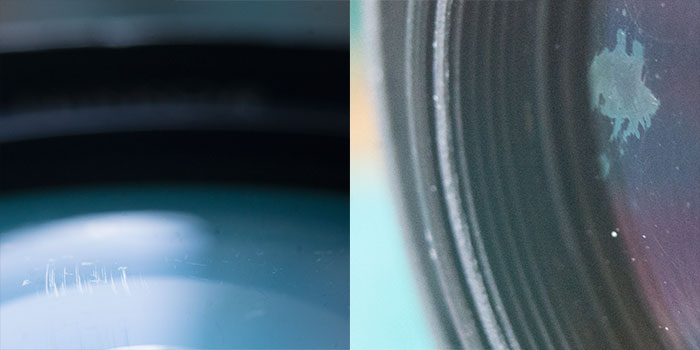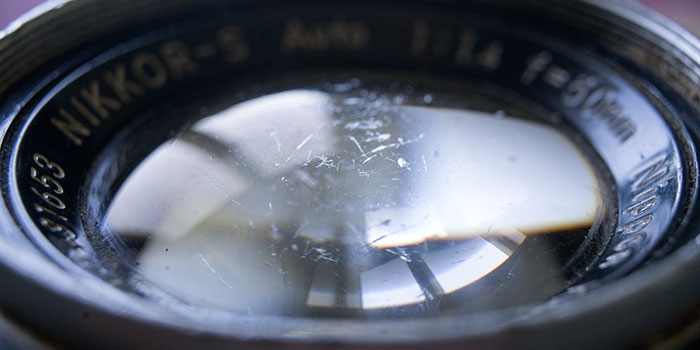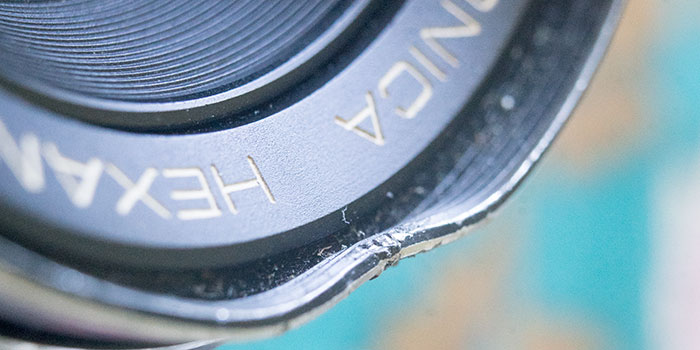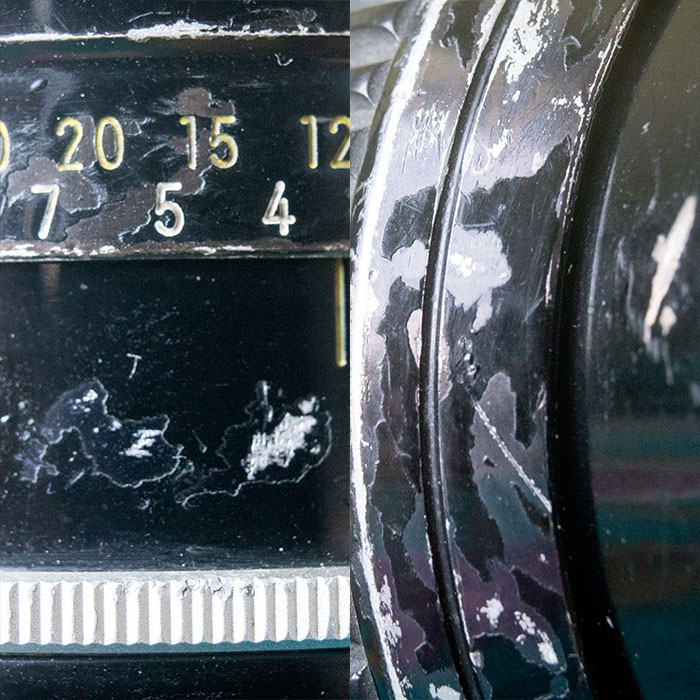Pekka Buttler, June 2020
Surface defects (in this context) are defects, blemishes, stains etc. which are on the outer surface of the lens. Herein, we are clearly talking about two quite different kinds of beasts: those defects which are in the light path (i.e. on the outermost lens surfaces; front-and-back) and those which are not. (Dust and other stuff in between the lenses is the topic of the next article).
When we dig into the topic in detail, the multitudinousness of these defects becomes obvious. Thus, there is little general to be said (the devil is in the details). We’ll start with the optics, and continue onto the mechanics.
But before that – a few words of caution: Photographic lenses are delicate optical instruments, and the tolerances involved are minute. While I won’t pretend every lens leaves the factory perfectly calibrated, the risk of a lens producing sub-spec images increases minutely every time the lens is picked up and every day which goes by. More importantly, every time a lens is knocked around, that risk jumps by a few orders of magnitude.
This article covers many “surface defects” which are sure tell-tales of a lens having been subjected to treatment which implies significant risks that one lens element or another is out of whack. Therefore, one should look at outward symptoms like dinged barrels or bent filter rings not just as that, but also as big, flashing warning signs of potential underlying defects.
Big discount -time!
Surface defects in the optical path
The outer surfaces of the frontmost and rearmost lens elements are different than the rest of a lens’ element surfaces (which we will address in the next article) in that a) they are most easily cleaned; b) they are liable to sustain contact injuries. Therefore the types of defects on these surfaces which you should concern yourself with are not those which can be cleaned away with a breath of humid air and a microfibre cloth, but those which do not go away as easily (and might also at times be due to excessive cleaning).
Herein, it is noteworthy, that with most photographic lenses manufactured in the last 70 years, the outermost layers of the fore&rear lenses are not actually glass, but lens coatings. While these coatings are typically relatively resilient (you can’t ‘wash’ them away without chemicals that have no business in the vicinity of a lens), they are nevertheless susceptible to blunt (and less blunt) force trauma and friction ablation. Furthermore, coatings – especially the earlier ones – are at times liable to detach seemingly on their own accord. Most typically this is due to less-than-optimal processes during manufacturing (in other words, unclean surfaces and not sufficiently uniform solutions).
Damaged coatings
Before going on, we should make sure we know what these coatings are for. Typically (and there is variation), the optical coatings on lenses exist to serve two or three purposes:
a) minimize reflections, thus leading to less veiling flare and ghosting;
b) increase the percentage of light passed through the lens; and
c) to affect how well different wavelengths (e.g. UV) pass through the lens (only some lenses).
[BTW, If you have a penchant for physics, you’ll see that a and b are actually the same thing]
Therefore, when you have a coated lens surface which has coating damage, it may lead to increased flare etc., while lowering light conductivity. Incidentally, when discussing the front element, flare does not enter the picture (whatever light is reflected away from the front element does not play in the equation).

Right: Ablation damage (probably spontaneous) on rearmost element’s coating (Meyer-Optik Orestor 135mm f/2.8)
Photographed with Nikkor Ai 35 mm f/2.8 and 26 mm extension tubes at f/8 Sony a7R2
Damaged coatings are – for most intents and purposes – non-repairable. Yes, there are specialist labs which can give a lens element a polishing and a new coating, but the price we’re talking about makes this idea economically unviable with all but the most expensive lenses. So unless you need to repair the coatings of your Noct Nikkor (or some other similarly outrageously priced piece of optics), try to live with it.
Luckily, damaged coatings are surprisingly easy to live with. While they (especially on the front element) are quite clearly visible, their detrimental effect on pictures is non-existent except in the rarest of cases. While this might seem surprising at first, I’ll go into some of the details why this is so in the next article. In the meantime, I do say that coating damage should be worth a discount.
Damaged lens glass
If coatings are the topmost layer, you might think that whatever impact actually gets through the coating and manages to leave a dent in the glass would be serious stuff. And you might be right.
While I have seen online accounts starting with “Look what happened as I dropped my lens nose-down on a sharp…“, the situations in which lens elements have actually managed to split or crack are few and far between. I’ve never seen one IRL, and unless you’ve got a perverted interest in visual aberrations, I recommend you stay away from such lenses (at least, don’t pay real money).
“Wait one…”, you might say. “…What if I get a new front element from a donor lens…?“
Yes, that might work, about as often as you get a raise without having to ask for it. The simple fact is that whatever knock has been strong enough to crack a lens element (remember, it’s not quite regular window-pane-glass), will probably have produced damage further down into a lens than what is outwardly visible. Proceed at your own risk.
But besides the really cracked lens elements, there are all those scrapes, bruises and minor dints, which are easily suffered when the frontmost lens element is not sufficiently recessed. And we’re not just talking fisheyes and ultra-wides here.

The top of the frontmost lens element is less than 2 mm under the rim of the filter thread. With lenses such as this, a metal lens hood or protective filter are relevant. Also, beware that you lens cap does not touch the glass. Luckily this lens’ front glass is in perfect order.
Naturally, given the nature of most wide angle lenses and bright standard lenses, the front elements (at least, the most protruding parts of those) are liable to get dinged from time to time. Depending on the photographer, their photography and the amount of use the lens sees, the result may be somewhat spectacular.

I picked up the above shown sample cheap, but my decision to buy was not based on its price, but the story the salesman spun me. Apparently, the lens used to belong to a war correspondent (before his estate ended up with the seller). While I have no way to ascertain the truthfulness of the story, I like to think that the lens has seen action.
The lens in question not only has quite prominent dings and scrapes on the front element, it is dirty, and has scuffs and scrapes all over. I’m not even sure I want to try to clean away the dirt (some of which is visible in the filter threads above), because they’re part of the legacy. Nevertheless, the lens is mechanically fully functional and produces very nice pictures, albeit with a twist. (For more details, see this comparison post)
While none of these scrapes and blemishes on the front element show up in the picture as such, each of them marginally lessens the lens’ sharpness and contrast and increases flare-proneness. When we’re not – as in the case of this lens sample – talking about a single blemish, the cumulative effect can be clearly noticeable. Therefore, what you get with such lenses is a result that might be both highly interesting and unpredictable.
In sum, except in the rarest of cases, surface (coating or glass) damage on the front or rear element will not be discernible in the pictures. This does not mean that they would not affect the pictures at all, just that – while invisible in the picture – they lessen the lens’ sharpness, contrast and flare-proneness.
Physical trauma to the rearmost lens element is – while luckily rare – an altogether different story. Here the blemish has a significantly higher tendency to actually show up in the picture, especially with wide-angle lenses. As a result, physical damage to the rearmost lens element is something you need to take more seriously.
Surface defects on the barrel (etc.)
Surface defects to the barrel are, by nature, quite different. Furthermore, there is such a multitude of different minor surface defects, that I will be forced to ride roughshod over some of them. Suffice it to say, that I do not expect serious lens collectors to be reading these pages, so I will almost overlook all those surface defects which have no functional impact on the lens.
Almost, because there are some situations in which aesthetic defects are significant. Firstly, any significant aesthetic defect is cause for a discount, because even though you would not mind in the least, these defects have an affect on your prospective resale value. Secondly, sometimes the delineation between “functional” and “aesthetic” are less than clear-cut. Take for instance the depth-of-field markings often present on legacy lenses, which are not only visual (and a ‘nice touch’), but also serve a use.
Even so, I contend that there are three types of far more serious surface defects (outside of the optical path), namely: Severe denting of barrel, damage to the mount, and filter ring damage. The last of these is the most typical form of damage, while also being more severe than many would think.
Damaged filter rings
Almost all lenses have filter rings. Some of the exceptions are those lenses (typically fisheyes and ultrawides) that due to bulbous front elements could not mount a filter. Also Zeiss experimented with bayonet-mounted filters in the 1960s (hence, not offering filter threads). See one example here.
Today, filter use is by many considered optional, and the predominant rationale for using filters is for (physical) protection, but in the days of film photography, filters were of an altogether different importance: ambitious shooters of colour negative and slide film wanted to eradicate the effect UV-rays had on sunny days, and thus always carried UV-filters; users of B&W film with a similarly predisposition always at least had yellow filters in their bags.
Importantly, while they are generally referred to as ‘filter rings’, they typically serve a wider scale of uses than merely for mounting filters.
Before the advent of bayonet lens hoods, lens hoods were predominantly screwed into filter rings. Also, even with those lenses which have the facilities to accept a dedicated bayonet hood, their availability on the aftermarket may be limited (read: expensive), thus making it useful to be able to buy a cheap screw-in lens hood.
And while it may be a real drag to not be able to mount a filter or a lens hood, the real importance of the filter ring is that most legacy lenses rely on the filter ring for accessing some of the lens’ innards.

The lens had fungus, a jammed diaphragm and was drenched in gunk. Disassembly necessitated screwing out the nameplate (even though the filter ring was dented). Against all odds, it worked, but it was a pain.
Legacy lenses generally are highly repairable, due to a combination of quality materials and relatively simple construction. Their repairability can make them effectively eternal (when treated well). But a legacy lens with a dented filter ring might have its days numbered. While a dented filter ring does not necessarily make accessing the lens innards impossible, it certainly lessens the chances of a successful repair. Therefore, a dented filter ring is potentially a very serious type of damage.
There are lens vices – dedicated tools for the straightening of filter rings – and their pricing is attractive but a word of warning is necessary: First, these tools might manage to straighten the lens barrel, but simultaneously ruin the threads. Second, your chance of success in using these tools declines radically with bigger dents. Finally, the use of a lens vise to try to straighten the barrel and correct the threads has a significantly higher chance of success (while simultaneously lessening the risk of damage to other parts) if the lens has already been taken apart – an almost perfect catch-22.
But dents are not the only type of damage filter rings may accrue. Especially, as (even among legacy lenses) some lenses filter rings are not made of metal, but are instead of plastic. While plastic filter rings have some advantages (an overall lighter construction, and a lower risk of a filter becoming stuck), plastic has two distinct downsides: Firstly, as filters are made of metal, the frequent threading/unthread is of filters may create a lot of wear on the threads on the lens, which – given time – may result in the threads being stripped. Secondly, an impact which would lead to a dent in a metal filter ring might break a plastic filter ring. (BTW, never use a lens vise on a plastic filter ring.)

While it looks bad, filters and lens hood can still be mounted, and nameplate can be theaded out. Thus this lens remains perfectly serviceable.
Whether a the risk for filter rings breaking is a bad thing is debatable, as a broken plastic filter ring may – while certainly ugly and reason for a heavy discount – be less of a real-world problem. In many cases (as with the lens above) a small break in a plastic filter ring does not make the filter ring unable to serve its purpose, while a heavily dented filter ring certainly would.
Filter ring damage nevertheless is serious, and – depending on the construction of a lens – may actually not even be fixable with simple donor parts, as the filter ring often is integral to the forward barrel.
Damaged lens mount
There are two types of lens mount damage: excessive wear and trauma damage. Also, as I’m sure you know if you’ve read my article on lens mounts, lens mounts exist not only to allow the secure fastening and unfastening of a lens, but often also facilitate communication between camera body and lens. Hence, there are actually several functional elements of the lens mount which may incur damage.
Excessive wear: Every time you fasten/unfasten a lens mount, the lens mount wears a tiny bit. This is due to that (not surprisingly, if you’ve read the articles on oily blades and haze) lens mounts are not lubricated. Instead, with every operation of the lens mount, dry friction will always take its (luckily minor) toll on the mount. Naturally, the whole point of designing an interchangeable lens camera is to allow the changing of lenses, so all mounts can take a great deal of wear, before that wear becomes excessive wear. Then again, how much fastening and unfastening of lenses is needed until it becomes excessively worn, varies somewhat depending on the characteristics of the mount design.
When is wear excessive? Simply put, when one of the following criteria is met:
• When the lens no longer securely locks in place.
• When the lens, when mounted and locked, still allows significant freedom of movement (either rotation around the optical axis, or back-and-forth wiggling).
• When a OEM lens cap (rear) which sits snugly on other lenses does not fasten on the lens or falls off too easily.
Excessively worn lens mounts are bad, because they increase the risk of a lens dropping off the camera; potentially affect the functioning of electronic/mechanical communication between lens and body; and because a lens’ worn mount increases the strain on the mount at the camera’s (or adapter’s) end. The last point is a good litmus test: If you have a good condition lens cap (preferably from the original manufacturer), and it does not fit tightly on the lens’ mount, (but does with other lenses), then trouble is brewing, not least because this makes the mount more vulnerable.
Luckily, even an excessively worn lens is relatively easily repaired by swapping the worn-out lens mount with a spare part or a part from a donor lens.
Trauma damage. If filter ring damage typically results from the front end of a lens hitting something, mount damage can result from the rear end of the lens hitting something.
As lenses typically either sit snugly in a camera bag or are securely fastened to a camera body, trauma damage to the mount-end is luckily rare, and is typically caused either by dropping the lens during mounting/unmounting or by the lens bouncing around in the camera bag without a rear lens cap (see above).
Naturally, trauma damage may be massively destructive to any part of the lens, but most typically we are dealing with the opto-mechanical equivalents of cuts and bruises, i.e. minor deformations of the mount (threads or bayonet) and deformation (even breaking) of the lens-camera interfaces (pins, levers, electronic contacts).
Naturally, these are potentially more serious than simply an excessively worn mount, as mounting a lens with a deformation on its mount may necessitate some force, may scar the mount on the camera end and can also be difficult to unmount. Likewise, a bent pin or lever on a lens may damage the innards of the camera it is mounted on.
It is therefore important to
a) give the mount of every newly acquired or recently dropped lens a visual inspection and – if suspicions are raised – compare it with another lens for the same mount ,
b) mount every suspicious lens very carefully and without using force (and preferably on a cheap adapter (if available) instead of an expensive camera)
Again, broken, bent and misshaped parts can relatively easily be exchanged for functioning parts from a donor lens (this is nowhere as bad as element separation), but If you do not feel comfortable with the operation, leave it to a professional. Remember also, that whatever trauma hit the mount may have left deeper scars as well.
Severe denting of barrel
Lenses which have spent years or even decades outside the safe confines of a studio or display case will show some signs of use. In fact, you can argue that if you pick up a 50+ years old lens which looks like new, you should be sceptical, as – clearly – its previous owners did not think much of it as a photography tool.

Clearly this lens has seen some action, but remains in perfect mechanical and optical condition. Even so, due to its outward scruffiness, I was able to acquire it for 30% of a mint copy. If your intention is to look through your lenses (not look at your lenses), buying an outwardly frayed copy may be a budget-conscious approach.
That said, there is a difference between scuffs, dirt, and signs of abrasion and ‘severe denting’, so let’s start by defining what qualifies as severe denting:
When the lens’ barrel (not filter ring or mount) has deformities, which:
• impede the designed motion of any of the lens’ control rings (either by limiting that motion, or by adding significant friction, see here also)…
• clearly indicate that the lens has been subject to g-forces way outside of what you could consider normal use.
[As soon as I acquire a lens meeting these criteria, I’ll add a picture here.]
Again, any such dent should be inspected and considered with an eye towards “I wonder what else might be out of whack?” This also means that when considering the purchase of any lens which clearly has had a rough life: a) a hefty discount is called for; b) the lens should be rigorously tested (topic for an upcoming article)
That said, not every high-g impact leaves a telltale. Many lenses are sold with protective cases, which – while protecting the surface of a lens from outward defects – do little to lessen the actual g-forces associated with e.g. dropping a lens.
Should one try to repair dents or have them repaired? I’d argue that the only situation in which a dent should warrant repair is when the denting affects the workings of a control ring. In all other cases, the dent is purely optical, and what really matters is having the lens checked over to make sure nothing is wrong on the inside.
Read more:
Previous article: Part V: Control Ring Malfunction
Next article: Part VII: Dust and debris